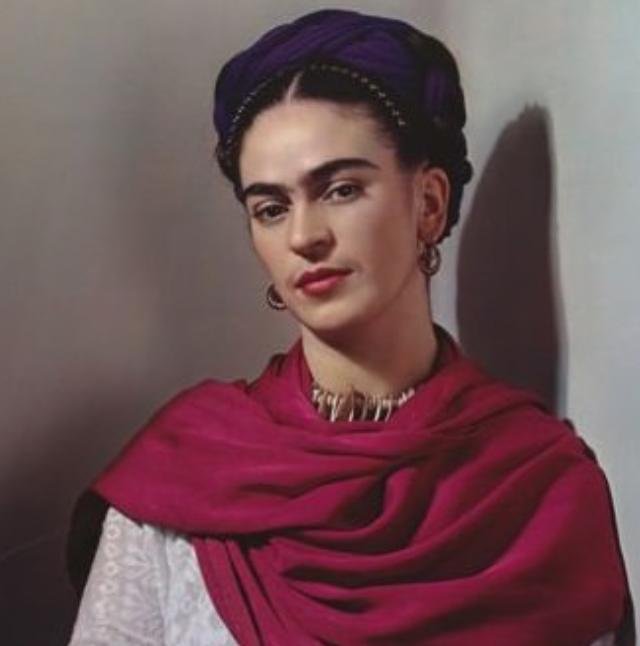Who ART You? 15
Frida Kahlo is one of the most well known painters in the world. The movie about her life certainly helped many come to know her work and life story as does visiting her childhood home and the one she shared with her husband Rivera which are both open to the public in Mexico City.
I had the opportunity to visit both when I was in Mexico City to host a Creative Art Session at a Creative Escape put on by @shopseektheuniq where we channeled the spirit of Frida Kahlo. Both houses are powerful and inspiring and give you insight into her work and share scenes from her everyday life.
Frida Kahlo did not sell many paintings in her lifetime, although she painted occasional portraits on commission. She had only one solo exhibition in Mexico in her lifetime, in 1953, just a year before her death at the age of 47.
Today, her works sell for very high prices. In May 2006, Frida Kahlo self-portrait, Roots, was sold for $5.62 million at a Sotheby's auction in New York, setting a record as the most expensive Latin American work ever purchased at auction, and also makes Frida Kahlo one of the highest-selling woman in art.
Frida Kahlo
Who ART You?
From www.fridakahlo.org
Mexican artist Frida Kahlo is remembered for her self-portraits, pain and passion, and bold, vibrant colors. She is celebrated in Mexico for her attention to Mexican and indigenous culture and by feminists for her depiction of the female experience and form.
Kahlo, who suffered from polio as a child, nearly died in a bus accident as a teenager. She suffered multiple fractures of her spine, collarbone and ribs, a shattered pelvis, broken foot and dislocated shoulder. She began to focus heavily on painting while recovering in a body cast. In her lifetime, she had 30 operations.
Life experience is a common theme in Kahlo's approximately 200 paintings, sketches and drawings. Her physical and emotional pain are depicted starkly on canvases, as is her turbulent relationship with her husband, fellow artist Diego Rivera, who she married twice. Of her 143 paintings, 55 are self-portraits.
The devastation to her body from the bus accident is shown in stark detail in The Broken Column. Kahlo is depicted nearly naked, split down the middle, with her spine presented as a broken decorative column. Her skin is dotted with nails. She is also fitted with a surgical brace.
Kahlo's first self-portrait was Self-Portrait in a Velvet Dress in 1926. It was painted in the style of 19th Century Mexican portrait painters who themselves were greatly influenced by the European Renaissance masters. She also sometimes drew from the Mexican painters in her use of a background of tied-back drapes. Self-Portrait - Time Flies (1929), Portrait of a a Woman in White (1930) and Self-Portrait Dedicated to Leon Trotsky (1937) all bear this background.
In her second-self portrait, "Time Flies," Kahlo uses a folk style and vibrant colors. She wears peasant clothing, and the red, white and green in the painting are the colors of the Mexican flag.
During her life, self portrait is a subject that Frida Kahlo always returns to, as artists have always returned to beloved themes - Vincent van Gogh his Sun Flowers, Paul Cezanne his Apples, and Claude Monet his Water Lilies.
Frida and Diego: Love and Pain
Kahlo and Rivera had a tumultuous relationship, marked by multiple affairs on both sides. Self-Portrait With Cropped Hair (1940), Kahlo is depicted in a man's suit, holding a pair of scissors, with her fallen hair around the chair in which she sits. This represents the times she would cut the hair Rivera loved when he had affairs.
The 1937 painting Memory, the Heart, shows Kahlo's pain over her husband's affair with her younger sister Christina. A large broken heart at her feet shows the intensity of Kahlo's anguish. Frido and Diego divorced in 1939, but reunited a year later and remarried. The Two Fridas (1939) depicts Kahlo twice, shortly after the divorce. One Frida wears a costume from the Tehuana region of Mexico, representing the Frida that Diego loved. The other Frida wears a European dress as the woman who Diego betrayed and rejected. Later, she is back in Tehuana dress in Self-Portrait as a Tehuana (1943) and Self Portrait(1948).
Pre-Columbian artifacts were common both in the Kahlo/Rivera home (Diego collected sculptures and idols, and Frido collected Jewelry) and in Kahlo's paintings. She wore jewelry from this period in "Self-Portrait -- Time Flies" (1926), Self-Portrait With Monkey (1938) and Self-Portrait With Braid (1941), among others. Other Pre-Columbian artifacts are found in The Four Inhabitants of Mexico City (1938), Girl With Death Mask (1938) and Self-Portrait With Small Monkeys (1945).
When asked why she painted so many self portraits, Frida Kahlo said, “I paint self-portraits because I am so often alone, because I am the person I know best."
Brought to you by www.janmccarthy.com
@janmccarthy
jan@janmccarthy.com
https://www.facebook.com/janmccarthystudio/
If you aren’t on my newsletter getting the lastest uptodate information, you may be missing out. Sign up here. Not only will I be offering some really rad online art workshops in the future that I know you will like, (say yes!), but I will be hosting a random drawing in the weeks to come! But only my subscribers to the newsletter, (not just the blog) will be eligble to win.
Follow me on IG ( @janmccarthy ) to get the lastest photo ops from my neighborhood (whichever one I happen to be in)

